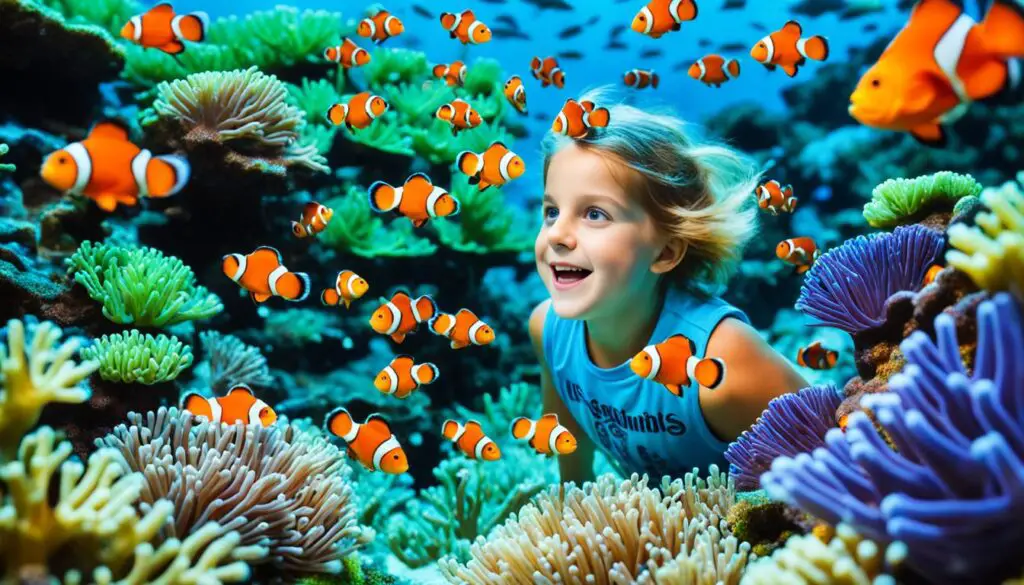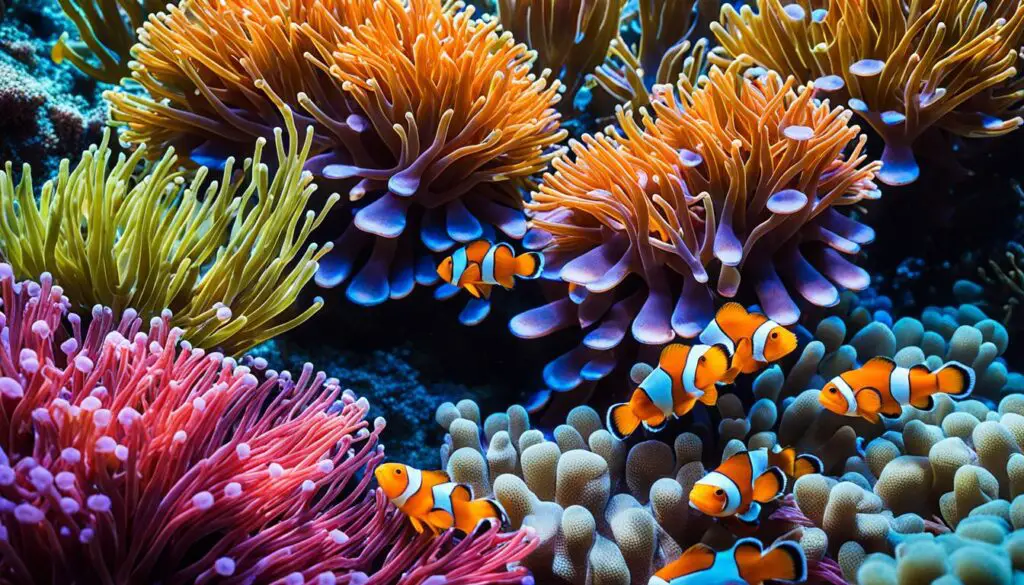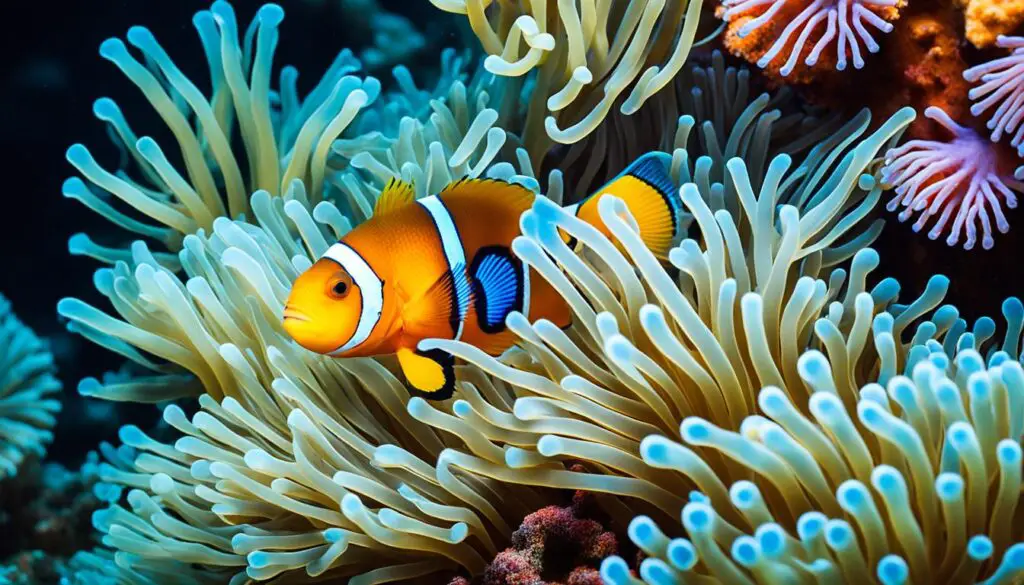Marine Biodiversity Conservation: Safeguarding Diversity
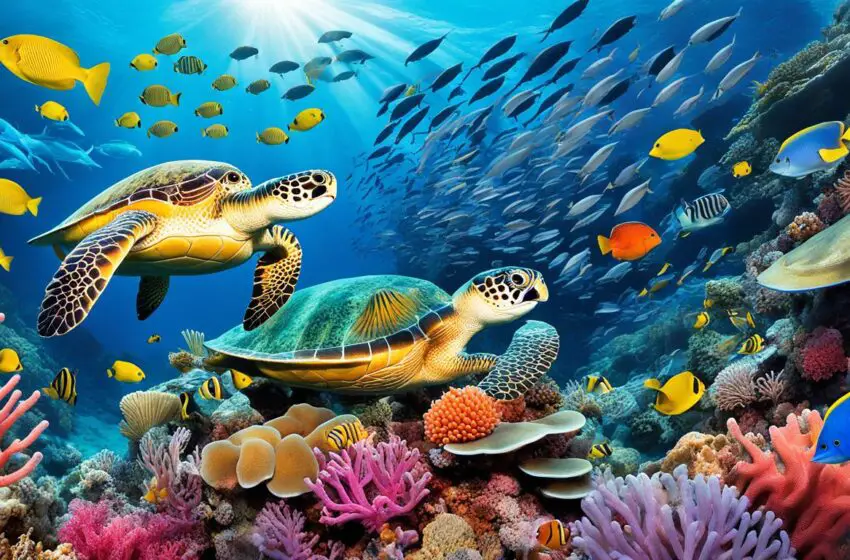
Marine ecosystems and their life forms are critical for Earth’s health. They help with the oxygen and carbon cycles, provide food, and help people earn a living. But, actions like overfishing and climate change are hurting marine life.
It’s vital to protect these marine ecosystems for our future. We need smart and flexible ways of managing them. This should encourage fair and lasting use of the sea. We must act now to stop losing biodiversity and keep the oceans healthy for our kids.
Key Takeaways:
- Marine ecosystems and biodiversity are essential for the health of our planet.
- Unsustainable human activities and climate change threaten marine biodiversity.
- Integrative and adaptive management approaches are crucial for protecting marine ecosystems.
- Immediate action is needed to prevent further biodiversity loss.
- Safeguarding marine biodiversity ensures a sustainable future for all.
Decline of Marine Biodiversity: Causes and Impacts
The drop in marine life worldwide is a big worry. Things like overfishing, pollution, and global warming are making oceans sicker. This leads to less variety in sea life, changing ecosystems, and even creating new types of ecosystems. All this can make entire ecosystems crash, putting many species at risk.
The fewer sea creatures there are, the harder it is for the oceans to help us. They keep our climate stable, guard our shores, and offer us food and medicine. But we’re messing up this natural order, so the services oceans provide are in danger.
Without marine biodiversity, ecosystem function is compromised, species distribution shifts, and ecosystem collapses occur, endangering the well-being of both marine life and human populations.
Man-made issues like overfishing throw off the ocean’s food chain. This messes with everything living there. When some animals can’t live in their usual places anymore, they can’t do their jobs in the ecosystem. And without diverse and healthy marine life, places near the coast suffer.
Also, all these human-caused problems sometimes create new kinds of ecosystems. There, foreign species might take over, and the locals might not make it. We’re not sure how this will affect the oceans in the long run.
The lack of sea life hits people’s wallets too. Places that bank on ocean activities lose money. And when we take too many fish, it hurts the job of fishermen and our food supply.
| Impacts of Declining Marine Biodiversity | Examples |
|---|---|
| Loss of ecosystem functions | * Disrupted nutrient cycling and energy flow * Reduced stability and resilience of coastal communities |
| Species distribution shifts | * Movement of species to new habitats * Loss of species unable to adapt or find suitable habitats |
| Ecosystem collapse | * Fragmented and degraded habitats * Dominance of invasive species |
| Socio-economic impacts | * Decline in tourism and recreational activities * Disrupted sustainable fisheries and food security |
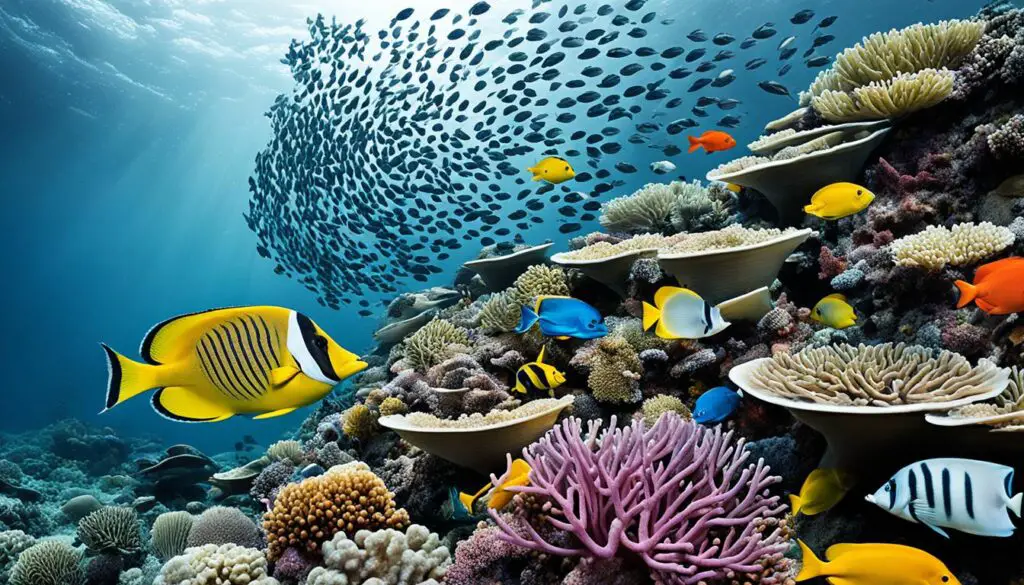
We need to act now to save ocean life. It must be a worldwide effort. We have to not only stop direct harm like overfishing but also fix the bigger issues like how we use up resources and climate change.
Sources of Anthropogenic Stress on Marine Biodiversity
- Overfishing and destructive fishing practices
- Habitat destruction and degradation
- Pollution from land-based sources, including plastic waste and chemical contaminants
- Climate change, including temperature rise, ocean acidification, and sea level rise
We can tackle these problems by setting policies, eating seafood responsibly, fixing habitats, cutting back on pollution, and fighting climate change. By saving marine life, we’re protecting our world and those who’ll come after us.
Marine Protected Areas: Conservation Tool for Biodiversity
Marine Protected Areas (MPAs) are key to keeping our ocean life safe. They act as safe zones for many marine species. By reducing or stopping human activities, these areas help ecosystems and species to recover.
MPAs show they work by helping fish populations. These areas provide a place for marine life to flourish. This helps keep our fish supplies healthy.
But, MPAs are not a complete solution on their own. They can’t stop all the problems, like too many people living unsustainably. These issues don’t stay inside MPAs’ borders.
To really save marine life, we must work together. Everyone must help, from people to companies to governments. This way, we can tackle the root problems and embrace earth-friendly ways of living.
Getting involved in managing ecosystems wisely protects our sea’s balance. It ensures we can keep fishing in a way that doesn’t harm the ocean. Saving our seas matters. Let’s focus on helping Marine Protected Areas and doing more to care for our planet.
The Benefits of Marine Protected Areas
MPAs bring good things for our sea life and for us:
- Biodiversity conservation: They offer safety to many marine species, protecting their genes and the whole ecosystem.
- Ecosystem resilience: MPAs make ecosystems stronger by keeping their homes safe from human harm. This helps them survive changes better.
- Sustainable fisheries: They help fish populations grow well. This keeps the ocean in balance and supports fishermen’s jobs.
- Educational and scientific opportunities: MPAs are great study spots for marine scientists. They learn a lot about the sea and how to protect it.
- Recreational and tourism value: These areas are playgrounds for water fun like snorkeling and boating. They also bring money to local economies.
Marine Protected Areas are crucial for keeping our ocean’s life healthy. With better rules and human care, our sea can stay vibrant for years to come.
“The establishment and effective management of Marine Protected Areas are essential for the conservation of marine biodiversity and the sustainability of fisheries.” – Dr. Jane Jones, Marine Biologist
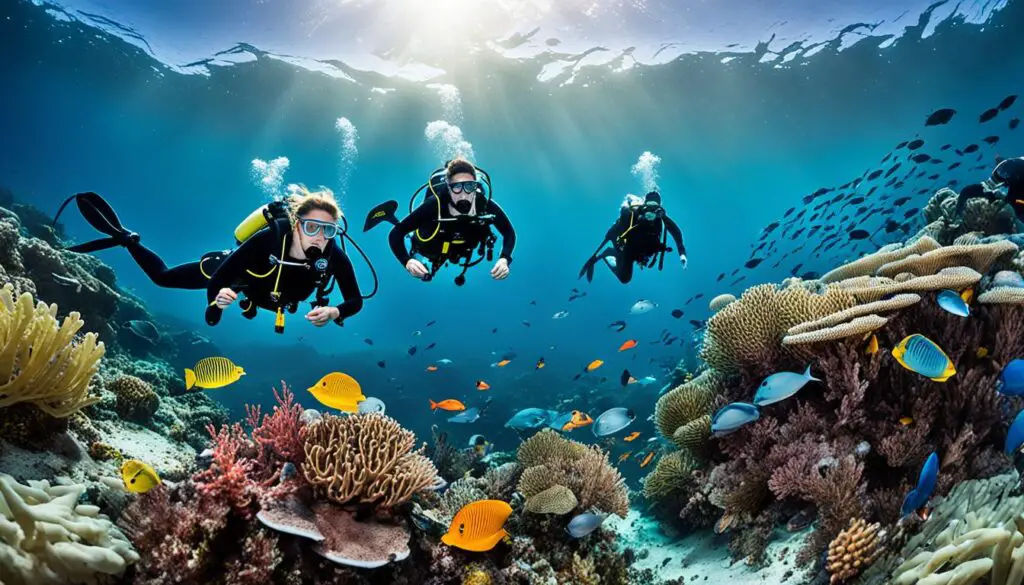
The Need for Collaboration and Action
To save our sea life, we all need to work and act together:
- Government and policy-makers: They need to make and follow rules that protect sea life. This means ensuring MPAs are well-run.
- Local communities and indigenous peoples: People near MPAs should help decide how to care for them. This makes sure the areas work well and are looked after.
- Scientific community: Scientists help by studying the ocean and giving advice on how to best protect it. Their work is key.
- Industry and business sectors: Companies using the sea’s resources should act in ways that don’t harm them. They can also help save the sea life.
- Civil society and non-governmental organizations: These groups can inform others about ocean issues and push for their protection. They rally support for MPAs too.
By working in partnership, we can keep the ocean healthy for the future. With quick action, we can make sure marine life not only survives but thrives. This benefits both nature and people’s lives.
Conclusion
Marine life conservation is critical for our oceans’ health and a lasting future. We need to use smart and flexible ways to care for marine places fairly and for the long term. Changing how we use, earn, and build things with the sea is key to keep it safe.
Getting to a future where we can go on sustainably living needs smart plans. But we also need to act now to stop things from getting worse. With better ways to manage, saving life underwater, and using new tech, we can make a real chance for a lasting future, not just by 2030 but for a long time ahead.
The UN’s Ocean Science Decade is our big chance to come together for marine life. Let’s take care of our oceans everywhere and right away, to keep life down there plentiful and the sea’s gifts for us safe. We can work together for a world where the ocean is full of life, which means a better place for everyone.
FAQ
Why is marine biodiversity conservation important?
Conserving marine biodiversity is key to keep our oceans healthy. It guarantees a future where we live sustainably. The oceans offer crucial benefits like balancing our climate, creating food, and giving us medicines.
They even protect our shores and support jobs in many industries. By saving marine life, we make sure these benefits continue for us and future generations.
What are the main causes and impacts of the decline in marine biodiversity?
The main causes of biodiversity loss in the sea come from human actions. These include overfishing, harming habitats, pollution, and changing climates. These problems are leading to the loss of species and functions in marine systems.
This loss can lead to entire systems falling apart, which is bad news for many living things. And it affects us too, since we depend on the sea for so much.
How do Marine Protected Areas contribute to biodiversity conservation?
MPAs are special zones where human activity is limited or banned. They help protect our ocean’s health by allowing species and ecosystems to recover. They’re great for keeping fish populations in check too.
By using MPAs well, we can make sure our seas stay rich in life. But they’re just one part of a bigger strategy needed for true conservation.
What is the role of immediate action in marine biodiversity conservation?
Right now, acting fast is critical to saving our seas. We need to better manage our activities, protect biodiversity, and use new tech wisely. This is our best chance for a lasting balance.
The UN has set a special ten years to focus on saving the oceans. It’s a chance for everyone to work together to keep our seas full of life.

